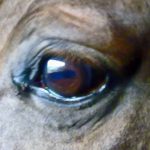 Much, if not most of the time that we humans spend interacting with our horse is devoted to behaviourist training, such as habituation, or positive or negative reinforcement. How many of us are aware that behaviourist training is not only exceedingly limited but also even destructive?
Much, if not most of the time that we humans spend interacting with our horse is devoted to behaviourist training, such as habituation, or positive or negative reinforcement. How many of us are aware that behaviourist training is not only exceedingly limited but also even destructive?
|
The bulk of the behaviourist training which humans subject horses to takes the form of:
- habituation; and
- positive or negative reinforcement, or a combination of both.
“Science-based” or “natural”
There are those who claim that behaviourist learning (and hence also training) is:
- “science-based”;
- a “natural” phenomenon based on the hierarchy of dominance discernible in horses in the wild.
“Natural” is a myth in that equine ethology studies reveal that the notion of horses in the wild living in hierarchies of dominance is a myth, and horses do not or hardly ever employ behaviourist learning as a form of training.
“Science-based” is usually a claim made by people who are not senior or leading members of the scientific community and who, unlike the latter, seem to ignore the limitations of science. Such limitations include:
- laboratory-based experimentation which is partly divorced from real-life situations;
- science’s inability to explain many phenomena;
- what may be deemed to be scientifically acceptable at one stage may subsequently be considered to be scientifically harmful.
Behaviourist learning theory or training method?
Behaviourist learning theory is about learning and not training. It explains how the horse learns not how the human trains. As a theory, it is also not an incontestable fact and, being hypothetical by nature, is capable of being disproved. Yet humans apply this learning theory as though it is a training method.
Essentially, behaviourist learning theory acknowledges that the horse mechanistically acquires conditioned behaviour. As such, no cognitive learning may be involved.
When incorporated into a training regime, behaviourist learning theory assumes that any learning on the part of the horse is confined to behaviour. All other potential avenues for learning – and there are many – are excluded.
Destructive
The use of habituation and the negative reinforcement variant of operant conditioning as an approach to training is not only very limited but is also destructive. The equine ethologist, Lucy Rees, notes that most domestic horses “have little opportunity to investigate, explore, or reach their own conclusions and decisions, for they are too restricted and controlled” and that, if they “are brought up in dull, unvarying environments, repeating the same mindless exercises, they have little chance to learn and do not strike us as being bright”. She also notes, “the Italian ethologist Francisco de Giorgio insists, limiting our training to behaviourist control techniques annihilates their cognitive abilities and their satisfaction in using them.”
Horses are highly capable of communication and have a natural disposition towards it and affiliative interaction with members of their own and other species. This begs the question as to why humans largely avoid communication with horses in favour of behaviourist training and, as such, control.
When discussing methods and approaches, as in this case, it is important to acknowledge that a human factor is always involved. As such, perhaps it is advisable to bear in mind that an assessment of the methods and approaches discussed here are not intended to reflect on the practitioners who employ them.
Time to remove the blinkers of behaviourist training?
Around the world there is a growing tide of humans who are seeking an authentic way of relating to and interacting with their horse. On the one hand, we seek an authentic way of relating to and interacting with our horses but, on the other, we try and achieve this through behaviourist training, which by its very nature is the epitome of an approach that will prevent us from attaining the authenticity that we seek.
Horses are capable of far more than behaviourist learning and their repertoire extends to relatively advanced cognition, emotions, spontaneity, communication, connection, trust, joie de vivre, energy and more. All of these offer avenues for sharing and interaction between horse and human, don’t they? And if they do, why would any human want to confine, completely or largely, their interaction with a horse to the extremely narrow and destructive confines of behaviourist training? Is it not time to remove the blinkers of behaviourist training, so that we can finally see the horse?
Download the full discussion paper free of charge here:
http://www.horsesandhumans.com/documents/behaviourist-training.pdf.



